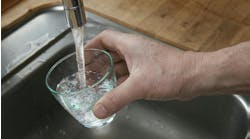We're delighted that Steve Lehtonen has gotten the GreenPlumbersUSA program off the ground. As we report on page 1 of this issue, Lehtonen, executive director of the Plumbing-Heating-Cooling Contractors of California and all-around pillar of the industry, inked a 15-year deal with the Master Plumbers & Mechanical Services Association of Australia to bring the program to the U.S.
The training and certification program has developed a five-course accreditation that totals 32 hours of training. The courses are Climate Care, Caring For Our Water, Solar Hot Water, Water Efficient Technology, and an Inspection Report Service.
The goal for 2008 in the United States is to train at least 8,000 Green Plumbers. A GreenPlumbers accreditation license for contractors supports and protects the integrity of the brand.
“In the next 10 years we plan to train 15,000 green plumbers in California and 40,000 nationally,” Lehtonen said. “We want to make the training free and available to all plumbers.”
Who better to promote the cause of water conservation than you who are in customers' homes and businesses all the time? The GreenPlumbersUSA certification will give you the knowledge and confidence to talk about products and services that save water.
The Australian model, upon which GreenPlumbersUSA is based, has accredited more than 5,000 Green Plumbers since 2001, representing more than 2,300 businesses in Australia. Water consumption in Australia has been reduced up to 50% from 1990 levels.
That's crucial in Australia, which has been suffering from drought so severe that it makes the recent drought in the southeast U.S. seem inconsequential. Some locales in Australia have turned to the grotesquely named toilet-to-tap water treatment system. Actually, most water treatment in the U.S. is, in a way, toilet-to-tap, but it just doesn't seem quite that direct, meandering as it does through wetlands, lakes and aquifers.
One interesting factoid that comes out of GreenPlumbersUSA is that the U.S. flushes 6.8 billion gallons of water down the toilet every day. I've said before here that it's insane that we flush our toilets with drinking water.
One way to attack that problem is with graywater recycling and rainwater harvesting, which we cover in a story on page 7. An impediment to graywater recycling is that water rates in the U.S. are too cheap, according to a division of Hansgrohe that is selling a graywater system in Europe. Whole house graywater systems require two drains, one for graywater and one for blackwater, plus pumps, tanks, filters and other purification equipment. Closer to home, a company called WaterSaver Technologies LLC is selling a system that collects water from a lavatory, filters it and pumps it into an adjoining toilet.
Jay R. Smith Mfg. Co. is selling a rainwater harvesting system that can, at its most basic, be an easy fit in most commercial buildings and can be used for landscape irrigation. The company also has components for residential rainwater systems.
In addition to cost, local codes are an impediment to graywater recycling and rainwater harvesting.
And, finally, we'd like to note a couple of news items that prove that water conservation works. The first is one you may have seen on www.contractormag.com about the “super sewage” being produced in Augusta, Ga. In places where water-conserving fixtures have been installed in great numbers, the sewage is not as diluted and the concentration of solids and biota is 300 PPM instead of the usual 200 PPM.
We also just ran across an article from the Toronto Star newspaper in Ontario, Canada, that noted that conservation means a lot less water revenues.
“Conservation is killing us,” said the Durham Region's public works boss Cliff Curtis. Curtis realized what he said and quickly added that there are a lot of reasons to conserve water.
Water bills are going down at a time when the region needs to spend money on infrastructure. Toronto is facing about $800 million (Canadian) worth of repair and replacement work, The Star reported, since half of the city's water mains and 30% of its sewer pipes are more than 50 years old. Last year, total revenue was only $604 million.
There doesn't seem to be a way to get around that problem. You need to have functioning pipes, but you also need to have enough water left in the reservoirs and lakes to pump through those pipes.

